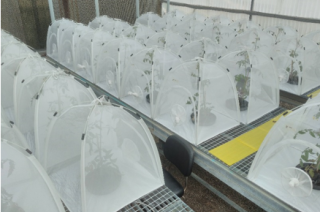
category_news
Impact of tomato trichome morphology on Biological Control Agents
Tomato trichomes have proved a challenge for the survival of some biological control agents but also for some of the most important pests. This is a delicate equilibrium and we are very much interested in promoting the performance of predatory mites against herbivores on tomato plants.
ESR update - These predatory mites are key in successful biological control strategies applied in protected crops. They predate on many plant-feeding arthropods, consuming large number of prey and often reproducing faster than their prey. However, they are not efficient on tomato crops, the largest vegetable planted in Europe.
Tomato plants are covered with hair-like structures, the so-called ‘trichomes’, that provide physical protection, but also produce a wide variety of insecticidal compounds for defence against herbivores; the most abundant of these secondary metabolites are sticky sugary compounds called ‘acylsugars’. Various herbivores species have evolved mechanisms to avoid trichome-mediated defences and attack tomato plants. However, our work has shown that the predatory mites are not adapted to these defences and that they get entrapped on the acylsugars while attempting to disperse across the plant.
Since we showed that beneficial mites are significantly affected by tomato trichomes, we looked for tomato varieties with different trichome phenotypes that might favour their performance and we found a tomato strain called hairless, that has a mutation on a specific gene causing deformities on the trichomes. Although trichomes on hairless tomato are distorted, they still produce and excrete secondary metabolites. Thus, we tested the dispersal of a generalist predatory mite, Amblyseius swirskii, and we found that it disperses longer distance on the hairless tomato if compared with the commercial variety. Based on this result, we have decided to test if this increase in the dispersal would also increase the capacity of the predatory mites to control key pests of tomato. Therefore, we are testing the performance of two predatory mites on hairless tomato: the generalist A. swirskii against whiteflies and the specialist Phytoseiulus persimilis against the two-spotted spider mite. For this reason (and because summer has arrived) we sent our tomato plants and their arthropod friends and foes for camping ;)! We wait to hear their experiences next month!